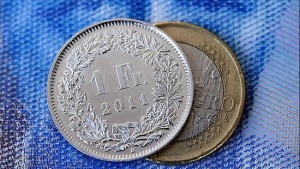 Friday’s trade saw EUR/CHF within the range of 1.0422-1.0510. The pair closed at 1.0468, down 0.11% on a daily basis and extending losses from Thursday. It has also been the fourth loss in the past five trading days. The cross depreciated 0.82% for the whole week. On Monday (March 30th) EUR/CHF may be influenced by a number of fundamentals, as listed below.
Friday’s trade saw EUR/CHF within the range of 1.0422-1.0510. The pair closed at 1.0468, down 0.11% on a daily basis and extending losses from Thursday. It has also been the fourth loss in the past five trading days. The cross depreciated 0.82% for the whole week. On Monday (March 30th) EUR/CHF may be influenced by a number of fundamentals, as listed below.
Fundamentals
Euro Area
Spanish consumer inflation – preliminary estimate
Spain’s annualized consumer inflation probably accelerated in March, reaching a level of -1.0%, the preliminary estimate is expected to reveal on Monday. If so, this would be the ninth consecutive month of negative inflation. In February the annual rate of inflation was reported at -1.1%, according to final data, released on March 12th, while in January – at -1.3%. In February the largest downward pressure came from sectors such as transportation (-5.6% year-on-year compared to -7.7% year-on-year in January). Housing cost fell 1.9% in the same month due to lower prices of electricity. On the other hand, prices of food and non-alcoholic beverages went up 0.2% in February, rebounding from a 0.4% drop in the preceding month, supported by higher prices of fresh vegetables, according to the report by the INE.
Key categories, included in Spans Consumer Price Index (CPI), are food and non-alcoholic beverages (accounting for 20% of the total weight) and transport (15%). Other categories are real estate (12%), hotels, coffee and restaurants (11.5%), clothing and footwear (9%) and entertainment and culture (7.5%). Health, communication, education and other goods and services comprise the remaining 25% of the index.
The CPI measures the change in price levels of the above mentioned basket of goods and services from consumer’s perspective and also provides clues over purchasing trends. In case the annualized CPI improved more than projected, this would have a limited bullish effect on the euro. The National Statistics Institute (INE) will release the preliminary inflation data at 7:00 GMT.
Spanish preliminary annualized CPI, evaluated in accordance with Eurostat’s harmonized methodology, probably fell at a pace of 0.9% in March, following a 1.2% decrease in February, as reported on March 12th. If so, this would be the ninth straight month of negative harmonized inflation.
Economic Sentiment Indicator (ESI)
The final value of the consumer confidence index probably confirmed the preliminary reading of -3.7, which was reported on March 23rd. If so, this would be the highest level of confidence since July 2007, when the indicator stood at -2.0. The final index for February came in at -6.7, or in line with the preliminary value. The indicator measures consumer confidence on a scale of -100 to +100. A reading of -100 suggests a lack of confidence, zero means neutrality and a reading of +100 indicates extreme levels of confidence. The index reflects the level of optimism, which consumers have about economic development in the region. The Business and Consumer Survey is conducted by phone and includes 23 000 households in the Euro area. The questions asked stress on current economic and financial situation, savings intention and also on expected developments regarding consumer price indexes, general economic situation and major purchases of durable goods. This indicator is one of the five major components, that comprise the Economic Sentiment Indicator (ESI).
The ESI probably continued to improve in March, reaching 103.1, according to market expectations, from a reading of 102.1 in February. If so, this would be the highest level since June 2011, when the index was reported at 105.4. The Economic Sentiment Indicator (ESI) is a composite indicator, consisting of five sectoral confidence indicators with different weights: Industrial confidence indicator, Services confidence indicator, Consumer confidence indicator, Construction confidence indicator and Retail trade confidence indicator. The ESI is calculated as an index with a mean value of 100.0 and standard deviation of 10 over a fixed standardized sample period.
Higher confidence usually implies greater willingness to spend, including large-ticket purchases, while consumer spending is a key factor behind economic growth. Therefore, in case the ESI climbed more than anticipated, this would cause a certain bullish impact on the common currency. The European Commission is expected to release the official ESI reading at 9:00 GMT.
German consumer inflation – preliminary estimate
German preliminary annualized consumer inflation probably accelerated to 0.3% during March, according to the median forecast by analysts. In February the final rate of inflation was reported at 0.1%, confirming the preliminary estimate, as prices of energy and food went down at a slower pace.
Energy costs plunged 7.3% year-on-year in February, as prices of heating oil plummeted 22.0% and prices of motor fuels dropped 12.7%. Prices of food and non-alcoholic beverages decreased 0.2% in February, following a 1.0% drop in January. Among services, in February higher prices were reported for net rents exclusive of heating expenses (+1.3%), passenger transport (+10.1%), hairdresser services and other services for personal care (+3.3%) and recreational and sporting services (+2.9%), according to data by Destatis. Cost of telecommunication services, on the other hand, continued to decline, down 1.1% year-on-year in the same month.
The Consumer Price Index (CPI) presents a general picture of the price change in the country, while encompassing all household types, all regions and all goods and services demanded (food, clothing, automobiles, rental, repair and hairdressing services etc). The index is based on a basket of goods and services, which is regularly renewed, so that goods and services, purchased more often by consumers, are included in the present survey.
The nations preliminary annualized CPI, evaluated in accordance with the harmonized methodology, probably rose 0.1% in March, after falling 0.1% in February and 0.5% in January. The harmonized methodology is used for the sake of consumer inflation comparison in an international context (member states in the Euro area). In case the annualized CPI improved more than expected and further approached the 2-percent inflation objective, set by the European Central Bank, this would certainly support demand for the euro. Destatis is scheduled to publish the CPI report at 12:00 GMT.
Pivot Points
According to Binary Tribune’s daily analysis, the central pivot point for the pair is at 1.0467. In case EUR/CHF manages to breach the first resistance level at 1.0511, it will probably continue up to test 1.0555. In case the second key resistance is broken, the pair will probably attempt to advance to 1.0599.
If EUR/CHF manages to breach the first key support at 1.0423, it will probably continue to slide and test 1.0379. With this second key support broken, the movement to the downside will probably continue to 1.0335.
The mid-Pivot levels for Monday are as follows: M1 – 1.0357, M2 – 1.0401, M3 – 1.0445, M4 – 1.0489, M5 – 1.0533, M6 – 1.0577.
In weekly terms, the central pivot point is at 1.0495. The three key resistance levels are as follows: R1 – 1.0579, R2 – 1.0689, R3 – 1.0773. The three key support levels are: S1 – 1.0385, S2 – 1.0301, S3 – 1.0191.





